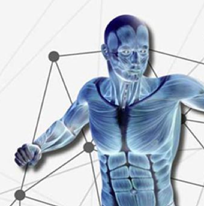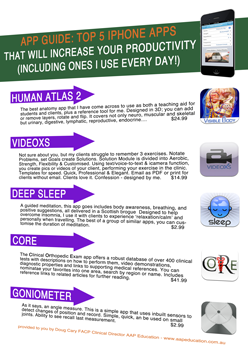Clinical Kit - 31/8/2015 - Fascial Manipulation -What Part Does it Play?
Todays Clinical Kit is a guest piece written by physiotherapist Diane Rowan on her experience with Fascial Manipulation.
Physiotherapy is ever changing. I believe this is the direct result of the many physiotherapists and researchers who are constantly striving to improve outcomes for the individuals who trust us on a daily basis to improve their function. As with most things in life, however the deeper you explore something the more you realize there is more to explore. This continual exploration is driving physiotherapy into perhaps one of the most exciting times in its history. Physiotherapists are recognizing, researching and unlocking previously disregarded or mystifying areas of the human body which are having profound impacts on the end user – our patients.
One of these areas is fascia.
I consider myself lucky that on my convoluted path of trying to obtain skills to improve patient function and look at them as more than a “body part” has resulted in me recently immersing myself into this “new” and exciting area.
Fascia has been largely disregarded by physiotherapists. It has been really only been considered a covering with no significant purpose or importance, which in itself is mystifying given it is everywhere! When you look at the anatomy and histology of fascia1 you can begin to understand how important it is.
It is so much more than a covering or casing for muscles. This should itself be evident by the fact that fascia is highly innervated. It also varies individually. Retinaculum, a part of the deep fascia, is absent in babies developing as the result of exposure to each individual’s interaction with the world through movement. Moreover, consider that 30-40% of muscle fibres either originates or inserts onto fascia. Its complex and intricate structure makes it ideal to provide optimal force transmission while providing an integrated proprioceptive role. It unites the limbs and the trunk allowing, in collaboration with the CNS, coordinated and complex movement patterning of the entire body. I like to think the muscles may make the noise but fascia turns it into music.
With the fascial system being so complex and extensive it can be daunting thinking of how, as physiotherapists, we can assess facia and then influence or optimize it to achieve positive outcome for our patients. Thankfully there are trailblazers in this field who have created interpretive models of assessment. Fascial Manipulation® is a model which originally was developed by Luigi Stecco, one of these trailblazers2. As a physiotherapist, he developed a model which is easy for physiotherapists to assimilate. Assessment allows the therapist to consider the individual and their experiences as a whole. It utilizes both movement testing and palpation skills to help determine dysfunction3. Manual skills are then utilized to treat specific dysfunctional points along the fascia to optimise and restoring tensional balance within the system. The outcome of treatment then is re-assessed through movement and function testing.
Fascial Manipulation® has only recently graced the shores of Australia. It was first presented in Australia in 2013, with the most recent introductory course being held in Perth in July. From speaking with former and recent course participants the general consensus seems to be “how did I not consider this before?”. The outcomes they are experiencing from implementing this model into practice have been undeniable, with the patients being the winners. I think this speaks volumes of both the importance of fascia and the model of Fascial Manipulation® as the attendee’s backgrounds, experience and caseloads have been diverse as I have ever met.
I would encourage any physiotherapists out there who interested in improving function and who enjoys being involved in an emerging area, to enrol in the upcoming Fascial Manipulation® Level 1 course being held in Perth at the end of this year. Additional information can be found through the AAP Education website (www.aapeducation.com.au) or at www.fascialmanipulation.com.
1. Functional Atlas of the Human Fascial System, C. Stecco, Churchill Livingstone, 2015.
2. Stecco L, Fascial Manipulation for Musculoskeletal Pain, Nuova Piccin, 2004
3. Stecco L, Stecco C. Fascial Manipulation: Practical Part. Nuova Piccin; 2009.
Thanks so much to Diane for her very informative article. You can find out more about Fascial Manipulation via the new Australian Facebook page in addition to the websites mentioned above.
Love to hear your thoughts and experiences.
Doug Cary FACP
Specialist Musculoskeletal Physiotherapist (awarded by Australian College of Physiotherapy, 2009)
PhD Candidate Curtin University
Clinical Director AAP Education
email: doug@aapeducation.com.au
ph/fx: 08 90715055
Receive a FREE Information Report
Choose The Top 5 Manual Therapy Apps or Infection Control & Needling (V3)
Along with the report you'll also get a complimentary subscription to "Clinical Kit" our regular eZine (email newsletter) and Free Bronze Membership. You'll get ideas, information, insight and inspiration on a regular basis, plus access to our Resource Library, helping you unravel those clinical conundrums appearing every day.
You are free to use material from the Blog in whole or in part, as long as you include complete attribution, including live website link. Please also notify me where the material will appear. The attribution should read: "By Doug Cary FACP of AAP Education. Please visit our website at www.aapeducation.com.au for additional clinical articles and resources on post graduate education for health professionals" (Please make sure the link is live if placed in an eZine or in a web site.)
HOME | DRY NEEDLING PROGRAM | CERVICAL SPINE | FASCIAL MANIPULATION | MULLIGANS | MSK & RT ULTRASOUND | NEURODYNAMIC SOLUTIONS | THE SHOULDER | VESTIBULAR PROGRAM | LIVING ANATOMY WET LABS | BLOG





